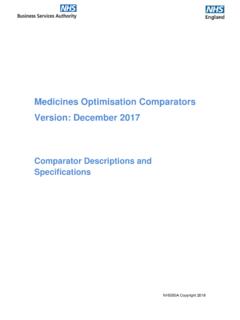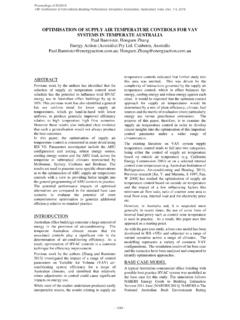Transcription of PROCESS DIAGNOSTIC STUDIES FOR CEMENT …
1 PROCESS DIAGNOSTIC STUDIES . FOR. CEMENT MILL optimisation - CASE STUDY. Batra*, D. Bhaskara Rao** and Raju Goyal**. Holtec Consulting Private Ltd., New Delhi ABSTRACT. Grinding technology has been continuously improving with numerous innovations with a view to improve productivity and reduce power consumption. In order to reduce the manufacturing costs for CEMENT , it is very important to optimise the existing mill installations as far as the grinding PROCESS is concerned and also to use high quality spare parts and consumables like grinding media . Ball mills are predominantly used machines for grinding in the CEMENT industry.
2 Although ball mills have been used for more than one hundred years, the design is still being improved in order to reduce the grinding costs. HOLTEC has undertaken Performance optimisation of the CEMENT grinding circuits by doing PROCESS DIAGNOSTIC STUDIES in many CEMENT plants. The paper describes the approach for the PROCESS DIAGNOSTIC study for the optimisation of a ball mill circuit and is supported with typical case study done by HOLTEC in a mio t/a CEMENT plant. The paper also describes the principle of the mill load control system developed by the Holderbank Engineering Canada Limited (HEC), Canada for the optimisation of the performance of the ball mills for obtaining maximum production and minimum specific energy consumption.
3 1. INTRODUCTION. The need for PROCESS optimisation through DIAGNOSTIC STUDIES has been increasingly felt as production costs are shooting upwards in conjunction with increased competition in the market. In order to reduce the manufacturing costs for CEMENT , it is very important to optimise the existing grinding installations. Experience has shown that the potential for optimisation is greatest in the CEMENT grinding PROCESS in a CEMENT plant The benefits that can be achieved due to the optimisation of CEMENT grinding system through PROCESS DIAGNOSTIC study are: Reduction in specific power consumption Increase in production Stable and sustained operation Increase in availability of the equipment - Less down time Improved and consistent product quality * Executive Director ** Dy.
4 Group Manager ** Manager The various types of grinding systems currently being used for CEMENT grinding in a CEMENT plant are: Conventional tube mill - Open and Close circuit Tube mill with precrushing unit vertical shaft impactor (VSI) or horizontal impact crusher (HIC). Roller press in semi finish and finish grinding mode Vertical roller mill (VRM). Ring roller mill or Horo mill Even though there are various types of systems available for CEMENT grinding, ball mills are predominantly used machines for CEMENT grinding in large number of CEMENT plants. In this paper authors are covering the PROCESS DIAGNOSTIC study of Ball mill for CEMENT grinding.
5 2. METHODOLOGY FOR PROCESS DIAGNOSTIC STUDY : BALL MILL. The PROCESS DIAGNOSTIC study for ball mill optimisation is carried out in following steps depending on the type of problem of the grinding system. DIAGNOSTIC STUDY. History of mill System Physical operations Design/Description inspection Operational Grinding system performance performance & testing Production Operation System Size Reduction Mill Philosophy Equipment Pattern Internals Sp. Power Control Feed Grinding Media Separator Consumption Philosophy Materials Distribution Internals Feed/Product Product Mass & Gas Mass & Gas Maintanace Characteristic Variety Flow Circuit Balance Down Time Control Separator Analysis Loop Performance /System Sampling Circuit Sampling Provisions The mill performance is evaluated and recommendations are formulated based on the past history of the mill operations, inspections, PROCESS measurements, feed/product characteristics and grinding performance, in order to improve mill output and reduction in power consumptions in the ball mill system.
6 3. CASE STUDY. A mio t/a CEMENT plant is having a closed circuit ball mill for CEMENT grinding: The mill has been operating with satisfactory performance in-terms of system availability and output, however power consumption was on higher side. System Description Mill Rated capacity 150 t/h OPC at 2800 I chamber liners Stepped blaine II chamber liners classifying Mill size x m L/D ratio Diaphragm Double blind Mill drive 5000 kW plate Mill speed rpm GM in I chamber 107 t Critical speed 76 % GM in II chamber 217 t Separator Sepax 450M-222 Separator Cyclone 4 nos. Separator motor 300 kW. Separator Fan 248300 m3/h ESP Fan 74100 m3/h 497 mmwg 375 mmwg 500 kW 110 kW.
7 Bag Filter Fan 21720 m3/h 185 mmwg 19 kW. Performance The mill is designed to handle a total ball charge of t at 100% loading with a percentage filling of in both the chambers. Both the chambers of the CEMENT mill were charged with 80% of the designed charge, which works out to 86 t in Ist chamber and 172 t in the IInd chamber. The mill is utilised for production of OPC 33 grade, OPC 53 grade and PPC. The blaines for the cements of different grades are being maintained as given below: Product Blaine Range(cm2/g). OPC 33 grade 2600-2700. OPC 53 grade 3000-3100. PPC 3100-3200. The productivity of the mill system as observed from the plant data is given below: Parameters Month Average A B C D.
8 Production rate t/h 126 130 143 140. Sp. power consumption kWh/t Product blaine m2/gm 270 273 272 274. The mill was operating at an average output of 135 t/h OPC and specific power consumption of kWh/t OPC. Observations and Diagnosis The CEMENT mill and the sepax separator were thoroughly inspected to observe internal condition of the mill and separator. During the inspection, mill and separator internal condition found in good condition and no coating on internals & material accumulation observed. However in Chamber I at a distance of 2 to 4. meters, around 5 broken/damaged liner plates were observed. Empty heights of both the chambers measured to calculate the ball charge, % filling and estimate the power consumption at mill shaft.
9 Based on the empty height measurements, charging of grinding media in Chambers I & II calculated as equivalent to degree of filling of 22% & 21% respectively. The estimated power consumption at mill shaft with this charge as 4110 kW. PROCESS measurements were conducted. The details and observations on PROCESS measurements are given below: Mill vent flow : 972 m3/min Separation air at separator outlet : 5599 m3/min Separator vent air at bag filter outlet : 210 m3/min The velocity of gases calculated through mill is m/sec. This velocity is sufficient for OPC33. grade grinding. The separation air at separator measured as Kg material/m3 at circulating load of , which indicates the availability of more classifying air in the system.
10 Due to high separation air, to obtain required blaine of the product, separator being operated at higher speed, which is contributing in higher circulating load and high bypass (High fines quantity in separator reject). The low vent volume through the bag filter is mainly due to very high pressure drop across the bag filter (180-200 mmWG). The actual flow measured is only 4% of the total separator air. Mill was crash stopped for collection of chamber samples to evaluate size reduction progress in side the mill. The results of sieve analysis are depicted as below: Size Reduction Progress I Chamber II Chamber 100 100 90 mic 90 90 212 mic 80 80.










